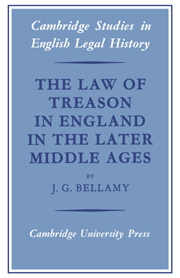Book contents
- Frontmatter
- Contents
- Editor's Preface
- Preface
- List of Abbreviations
- 1 The Medieval Concept of Treason
- 2 The Treatise Writers and the English Law of Treason at the End of the Thirteenth Century
- 3 The Origins of the English State Trial
- 4 The Great Statute of Treasons
- 5 The Scope of Treason, 1352–1485
- 6 Treason before the Courts, 1352–1485
- 7 The Origins and the Early History of the Act of Attainder
- 8 Treason and the Constitution
- Appendixes
- Select Bibliography
- Index
8 - Treason and the Constitution
Published online by Cambridge University Press: 14 October 2009
- Frontmatter
- Contents
- Editor's Preface
- Preface
- List of Abbreviations
- 1 The Medieval Concept of Treason
- 2 The Treatise Writers and the English Law of Treason at the End of the Thirteenth Century
- 3 The Origins of the English State Trial
- 4 The Great Statute of Treasons
- 5 The Scope of Treason, 1352–1485
- 6 Treason before the Courts, 1352–1485
- 7 The Origins and the Early History of the Act of Attainder
- 8 Treason and the Constitution
- Appendixes
- Select Bibliography
- Index
Summary
What was the role of the law of treason in English medieval history as a whole? The success of English medieval constitutionalism hinged on the balance of power between the king and the estates of the realm. After 1215 no king, however capable and powerful, was able to become a tyrant. The barons on the other hand, although they tried many times, were unable to transform the government into an oligarchy. The commons had no chance of changing the government into a democracy, but from 1300 they could not be ignored by either of the other two powers. The late medieval English law of treason was both a cause and a result of this balance and when it was tampered with, as for example in Richard II's reign, there was serious danger to constitutional government.
During most of the period under review the law of treason, because they held it so important, was subject to the watchful scrutiny of the barons and commons. On the interpretation of what constituted treason there generally prevailed between the king and his subjects a compromise, one which is well demonstrated by the fairly common use made in accusations of the phrase ‘treason against the realm’. This shows that many men believed more than the royal dignity was at stake. Quite obviously the king was mindful of his own duty to the crown, that is to the conceptual union of the monarch and his people. The first examples appeared at the end of the thirteenth century. In 1300 in a letter to Boniface VIII Edward I wrote about his quarrel with the Scots.
- Type
- Chapter
- Information
- The Law of Treason in England in the Later Middle Ages , pp. 206 - 215Publisher: Cambridge University PressPrint publication year: 1970

